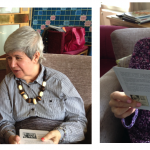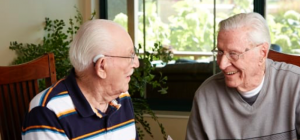
Meaningful conversation
Meaningful conversation is what many, if not most residents in care homes ache for. I am lucky to have facilitated a regular fortnightly conversation group of people in their 80s and 90s, living with dementia at one care home for nearly ten years. A handful of us sit together in a small group on our own in the lounge.
Some might advise against asking questions of people living with advanced dementia and I have some sympathy with this. People with dementia can find questions debilitating. So often, they refer to the recent past – or future, which negatively challenges a person’s damaged short-term memory. Questions like “how was breakfast?”, “what did you do today?” and so on, pretty much guarantee failure.
My mum had Alzheimer’s disease and vascular dementia. I often found myself intuitively ‘burbling’ at the start of conversations with her, as I have with the many of the lovely older people I’ve known over the last thirty years, whether they have dementia or not. It was my conversations with mum about her long-term memories that prompted me to develop Many Happy Returns cards and the REAL Communication framework.
Burbling and Seeding
Our conversation sessions always begin with settling in. I might talk about a few (positive) things I have on my mind for one reason or other. These may spawn a small selection of ideas that I then ‘seed’ for possible conversation. Once we’ve started, some questions can be helpful; as long as they are about the deep past and help to tap into the person’s long-term experiences, making them the expert.
At one session a few years ago, we were joined by N, a resident I hadn’t met before. Her carer took me aside to explain that N was in her nineties and had advanced dementia. “She might not be able to join in, but we think she might enjoy being with you and listening.” N looked distracted and tired. I wondered whether she would – or could join in, I knew nothing about her, but hoped she might enjoy the experience, nonetheless.
We started as we always do, sharing our names and our state of wellbeing. Seeding a few linked conversational notions for people to consider, I picked the ‘Make Do and Mend’ card from the 1940s set and what it meant to me.
“I was thinking about sewing baskets today. My mum’s wicker basket sat by her chair in the living room. It was full of colourful ‘Dewhurst Sylko’ reels and darning wool. There was a needle case with ‘Needles’, helpfully printed on the cover in case you’d forgotten… I remember a round shallow re-purposed Pascall Fruit Bonbons tin of pins, with its familiar rattling sound when opened. The lid was stiff and if you weren’t careful it would burst open, spilling pins all over the floor – with my mother frantically shooing the dog away. There was a little pair of scissors shaped like a stork and another, large heavier pair with long blades for cutting-out, as well as saw-toothed, ‘pinking shears’. There was a wooden darning mushroom, often in use… and always a few stray items short of a proper home, like buttons, cards of hooks and eyes and poppers. Sewing by hand… everyone used to do it, didn’t they…?”
And then, “I expect you all learned to sew and knit, did you? Perhaps it’s a shame we don’t do these things so much now…”
The Dress
Far from only being able to listen, N was the first to speak. To the astonishment of us all – and the complete disbelief of a few, she said, quite nonchalantly, “I was a seamstress and made Princess Marina’s wedding dress!” “WOW!” I exclaimed, feeling deep admiration and “How fantastic…!” and “Could you possibly tell us about it?”
Not so much a question as a suggestion. I could see and hear that she was really engaged and feeling more confident. A conversation with a person with advanced dementia can be like approaching a sensitive creature in the wild… move too fast and they might run away frightened, move too slowly and they might freeze. If we moved cautiously, might she share more?
N continued slowly, completely absorbed in her memory, “It was very simple and elegant, with a 17-foot train… quite understated really…” (see picture) she continued, with her own masterful understatement.
“Were you the only person to make it or was there a team?” I asked, working hard to keep a lid on my excitement. Long-forgotten fashion industry memories of my own popped up uninvited.
“Oh yes”, she continued, “there were five of us. There were two wedding dresses made, from specially woven white silk and real silver thread. It was fine, but very heavy.”
She went on to tell us about her job, the dress, its design by the couturier Molyneux; how an identical second dress was made in Paris by Russian refugees, “so that the unworn one could be exhibited at Buckingham Palace,” describing her team’s disappointment that in the end, it was the French dress that Princess Marina wore on the day – 29th November 1934, because of her special relationship with the people who made it.
N described in detail how the seamstresses sewed the hem in tiny sections, gesticulating the movement of the needle, thread and fabric, “we’d caste on, sew five stitches, and then caste off again,” so that if the heel of the bride’s shoe accidentally caught in it, “they were very high”, the whole hem wouldn’t unravel. N might have advanced dementia, but who would have known?
Stretching the conversation
Initially, there was general disbelief from one of our group, “don’t be ridiculous, of course she didn’t do that,” said another of our group dismissively, forgetting her usual good manners. “Well, it’s such an interesting story – perhaps we can talk about wedding dresses some more?” I replied, walking a bit of a tightrope between being tactful and not disagreeing.
And of course, as the conversation developed, everyone in the group joined in, sharing distant memories of their own wedding outfits and wedding bouquets and stories of more recent Royals, of Russian refugees and Princess Marina’s relationship with them, of jobs abroad, of late autumn weddings.
Finally, N told us that the English-made dress was the only one to survive, as the other was destroyed by a fire at Princess Marina’s home.
Ours was a happy group that day, as so often – the smiles, laughter and engagement proved that. “Thank you so much”, said one of the participants, afterwards, “I love these sessions”, “well thank YOU”, I replied, “it’s always a pleasure for me, too.” I really meant it.





No comment yet, add your voice below!